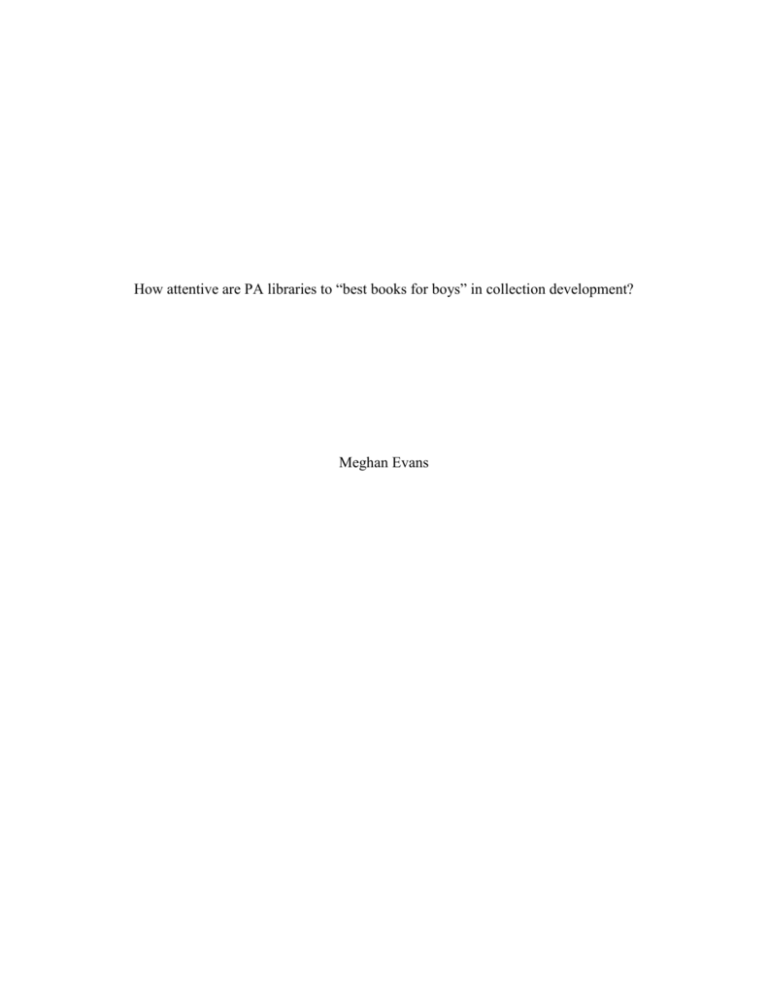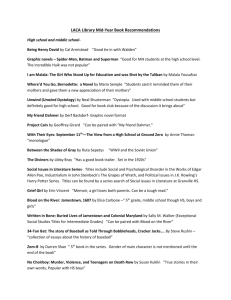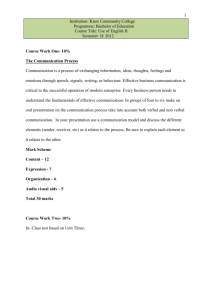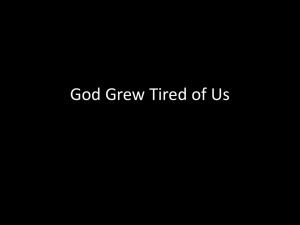How attentive are PA libraries to *best books for boys
advertisement

How attentive are PA libraries to “best books for boys” in collection development? Meghan Evans Introduction My son won’t read. It’s impossible to find something my son will enjoy reading. Can you recommend something other than “Captain Underpants” for my son to read? My boy won’t read the books his sister reads; do you have something he would like? Anyone who has worked in a children’s library for any length of time has heard these comments and questions. A look at the literature available concerning boys’ and reading indicates a decline in the reading levels of boys compared to girls of the same age. Is it that boys can’t find the kind of books they enjoy reading? How are public libraries serving this population? Are they providing enough access to books that are interesting to young male readers? For years public libraries have been using “Best Book” lists to help choose books for their collections. The American Library Association (ALA) and its affiliates publish lists each year naming the best books in several categories, including the well known Caldecott and Newbery medals. Numerous other lists, published by various organizations and businesses, exist to help libraries choose the best books for their patrons. This study examined the collections in Pennsylvania’s public libraries, focusing on the presence of “best books for boys” in those collections. In particular, it compared the holdings found in a random sample of Pennsylvania public libraries against a standard list of books suggested for boys, grades 1-5. Literature Review A review of the literature shows documentation of lower literacy rates for boys, differences in reading preferences by gender, and the existence of “best books for boys” lists. 2 The Gender Gap: Boys’ and Girls’ Reading Levels & Reading Preferences “According to the National Assessment of Education Progress (2009), female students consistently score higher than boys on average in both reading and writing.”1 Many studies had similar findings and are often used as the basis of concern when considering boys and their reading level, “determined by vocabulary, sentence structure, length of text, and difficulty of context” and “usually defined in reference to a specific grade level.”2 Michael Sullivan points out that “according to the U.S. Department of Education, school-age boys tend to read a grade and a half lower than girls.”3 Of course there are many other factors, beyond gender, that play into a person’s ability to read at a certain level, including “various social, cultural and institutional factors,”4 but those reasons are for another study. Boys’ lower reading levels are among the reasons to create lists of books specifically for boys, in hopes that books with appropriate reading levels will encourage boys to read more and thereby improve their reading skills. The other concern when creating boys’ reading lists is the difference in reading preferences between girls and boys. Studies consistently show that boys tend to prefer books with action and adventure, while girls tend to prefer books with inner dialog and emotional psychology. As Richie Partington explains, librarians “must seek to understand the differences between male and female reader preferences, then utilize this understanding to tailor services to 1 Kehler A. Watson, and W. Martino, “The problem of boys’ literacy underachievement: raising some questions” Journal of Adolescent & Adult Literacy, 53: 356-361, http://search.ebscohost.com/login.aspx?direct=true&db=a9h&AN=47875755&site=ehost-live&scope=site . 2 Online Dictionary for Library and Information Science, accessed October 16, 2010 3 Michael Sullivan, “Why Jonny won’t read” School Library Journal, 50: 36-39, http://search.ebscohost.com/login.aspx?direct=true&db=a9h&AN=14072668&site=ehost-live&scope=site . 4 Watson and Martino, “The problem of boys’ literacy underachievement: raising some questions”. 3 serve better each gender.”5 As with reading levels, the reasons for different reading preferences are multiple, and are the basis for many other studies. For this study it is enough to acknowledge that these differences exist, and that getting boys to read requires books that they enjoy. The Lists: Creating Boys’ Reading Lists Anyone can create a list. So, what makes a good list? And, for the purposes of this study, what makes a good boys’ reading list? According to Farris, Werderich, Nelson and Fuhler, boys tend to pick out books with the following characteristics: ● Books that look good [according to cover art or print styles] ● Books that are part of a series or by a favorite author ● Books with a character who goes through a number of situations or years ● Informational books with short passages supported by photographs and illustrations ● Graphic novels and graphic non-fiction6 Overall, the literature agrees that boys are behind girls in their reading levels and that their reading preferences vary from that of girls. These facts have prompted the creation of lists specifically aimed at boys with the objective of getting boys to read more and, in the process, increase their reading levels. When considering collection development, a casual observer might assume that those individuals responsible for managing a collection would consider such lists important to their decision making process. While this study realizes that other factors also contribute to collection management decisions, not the least of which are budgetary concerns, it 5 Richie Partington, “Why boy books”, CSLA Journal, 30: 15-16, http://search.ebscohost.com/login.aspx?direct=true&db=a9h&AN=22885746&site=ehost-live&scope=site P.J. Farris, D.E. Werderich, P.A. Nelson, and C.J. Fuhler, “Male Call: fifth-grade boys’ reading preferences”, Reading Teacher, 63: 180-188, http://search.ebscohost.com/login.aspx?direct=true&db=a9h&AN=44993785&site=ehost-live&scope=site. 6 4 will try to better understand how libraries are using recommendation lists of books for boys in their collection development. Methodology The Institute of Museum and Library Services (IMLS) provided reports based on the Public Library Survey of 2007, from which a list of 629 stationary outlets, central and branch libraries but not bookmobiles, were acquired7. A random flip of a coin, heads for even and tales for odd, decided how to start the list. From one, and following every other library, a list of 307 libraries was created. This allowed for a 95% confidence level and a confidence interval of 4. All libraries needed online catalogs; if a library did not have an online catalog the next library on the list was chosen. The chosen libraries and their holdings were then entered into an excel spreadsheet for data collection. Libraries who did not report holdings to IMLS for 2007 were eliminated from comparisons. The book list was selected based on: a review of the collection development literature, “best books” lists by ALA and other affiliates, and high recommendations with positive journal reviews. In researching “best book” lists, especially for boys, the author Michael Sullivan, an experienced and knowledgeable advocate of boys and reading, was discovered to have particular expertise. His books, published by ALA, include Connecting Boys with Books: what libraries can do, Connecting Boys with Books 2: closing the reading gap, Serving Boys through Readers’ Advisory and Fundamentals of Children’s Services. His website, Tales Told Tall, is updated with recommended books for boys. The lists can be searched by grade level, subject area and genre. For this study, Michael Sulivan’s website list of 240 titles for boys in grades 1-5 (elementary 7 Institute of Museum and Library Services, Public Libraries in the United States: Fiscal Year 2007, retrieved November 22, 2010 from http://harvester.census.gov/imls/pubs/pls/pub_detail.asp?id=122 5 grades) was used. The list is organized according to the following genres: action/adventure/mystery, comics/manga/graphic novels, fantasy, gothic horror, historical fiction, humor, nonfiction, picture books, sci-fi, and sports–lists with all of the characteristics which boys find appealing according to Farris, et al. Bibliographic information recorded on the Excel spreadsheet included title, author, publisher, the year the item was published, and the series title when appropriate. Utilizing an excel sheet with the library names and the book titles, a yes or no was entered depending on the holdings found through a search of each library’s online catalog. Results On average, the libraries had 94 of the 240 titles available, approximately 39 percent of the listed titles. The library with the fewest titles had 36 items available, and the library with the most titles had 168 titles available; a range of 132. Findings per title showed one title, “Deep Space Disco,” with zero holdings while the most popular title, “Captain Underpants and the Perilous Plight of the Purple Potty People,” was available in 289, or 94 percent, of the libraries. These are both in the comic/manga/graphic novel genre, the third most popular genre in the libraries’ holdings. As shown in Figure 1, of the 11 genres, fantasy and picture books were the most popular and gothic horror was the least. On average a title was available in 120 libraries. Most libraries held on average 39 percent of the titles, less than half of the titles recommended by Michael Sullivan’s books for boys list. The top ten most commonly held titles were all from two series written by two authors, Dav Pilkey and Jon Scieszka. Pilkey is the author of the Captain Underpants series and Scieszka 6 is the author of the Time Warp Trio series. On the other hand, the least popular titles are a less homogenized group of titles, authors and genres. Fig.1 The percentage of titles per genre held by libraries. One of the most difficult areas of this study is the determination of what is an “acceptable” number of books in a library. How do we draw the proverbial “line in the sand” in regards to a good collection or a bad collection? The answer to this is as varied as the number of different libraries. Each library, according to the size of its collection and budget, should examine their holdings with an eye to a well rounded collection. Overall size of the libraries’ holdings was determined from the IMLS 2007 report. A look at the number of items held by a library does not indicate a strong correlation between the availability of the best books for boys titles and collection size. The two smallest libraries, with roughly 6,000 items cataloged, averaged 98 titles, while the two largest libraries, each with over two million cataloged items, averaged 106 titles from the list–a difference of only eight titles. 7 Conclusion This study gives an overview of the collections of best books for boys currently held by public libraries in Pennsylvania. It is intended to be a starting point for further studies, a look at where these libraries are now with respect to books recommended for boys. Anecdotal evidence suggests that librarians use a multitude of factors to decide what books they will add to their collections. Patron requests, book reviews, award winners, and not least, cost can affect which books are chosen for collections. Further studies may include a look at how these holdings compare to other “List” holdings, such as Caldecott or other Association for Library Service to Children (ALSC) recommended books. An in depth look at how collection development decisions are made and the factors that affect decision making processes relating to the selection of boys’ reading materials would also be an interesting follow up to this study. Were any lists used to help in the decision making process? How does the budget allotment of a library affect the development of the collection? A closer look at collections may also be required to know if some items were once available but were lost/stolen/discarded and never replaced, perhaps because of budgetary restraints. In retrospect the data shows that overall collection size is not necessarily a major deciding factor in guaranteeing access to certain books. Most libraries will have some of the books from the books for boys list, usually about 30 or 40 percent. Perhaps the next question is, how are libraries utilizing and displaying these books in ways that entice boys to read? 8 Appendix Least Popular Titles # holdings available 0 Title Author Deep Space Disco Craddock, Eric 7 Please Don’t Eat the Children 12 Genre Publisher Greenburg, Dan Comic/manga/ graphic novel Gothic Horror Random House for Young Readers Harcourt Children's Books Grossology and You Branzei, Sylvia Nonfiction Price Stern Sloan 12 Pirate Palooza Craddock, Eric 13 Yikes! It’s Alive! Peter, Lerangis Comic/manga/ graphic novel Action, Adventure, Mystery Random House for Young Readers Scholastic Paperbacks 13 Whoa! Amusement Park Gone Wild. Peter, Lerangis Action, Adventure, Mystery Scholastic Paperbacks 13 Mummy Duey, Kathleen Comics/Manga/Graphic Novels Big Guy Books 14 Samurai Duey, Kathleen Comics/Manga/Graphic Novels Big Guy Books 18 Escapade Johnson and the Phantom of the Science Fair Sullivan, Michael Humor Publishing Works 18 The Buffalo Train Ride Webber, Desiree Nonfiction Eakin Press Table 1. Top ten titles with the least holdings available per library 9 Most Popular Titles # holdings available Title Author Genre Publisher 289 Captain Underpants and the Preposterous Plight of the Purple Potty People Pilkey, Dav Comics/Manga/Graphic Novels Blue Sky Press 288 Captain Underpants and the Wrath of the Wicked Wedgie Woman The Adventures of Captain Underpants: an Epic Novel Pilkey, Dav Comics/Manga/Graphic Novels Blue Sky Press Pilkey, Dav Comics/Manga/Graphic Novels Blue Sky Press 280 Captain Underpants and the Attack of the Talking Toilets Pilkey, Dav Comics/Manga/Graphic Novels Blue Sky Press 276 Captain Underpants and the Perilous Plot of Professor Poopypants Pilkey, Dav Comics/Manga/Graphic Novels Blue Sky Press 275 Captain Underpants and the Invasion of the Incredibly Naughty Cafeteria Ladies From Outer Space (and the Subsequent Assault of Equally Evil Lunchroom Zombie Nerds) Pilkey, Dav Comics/Manga/Graphic Novels Blue Sky Press 268 Captain Underpants and the Big, Bad Battle of the Bionic Booger Boy, Part 1: The Night of the Nasty Nostril Nuggets Pilkey, Dav Comics/Manga/Graphic Novels Blue Sky Press 268 Summer Reading is Killing Me The Good, The Bad, and the Goofy Scieszka, Jon Fantasy Viking Scieszka, Jon Fantasy Viking 2095 Scieszka, Jon Fantasy Viking 288 261 260 Table 2. Top ten titles with the most holdings available per library 10 Bibliography Association for Library Services to Children. ALSC book & media awards. Retrieved January 29, 2010, from http://www.ala.org/ala/mgrps/divs/alsc/awardsgrants/bookmedia/index.cfm Baxter, K., & Dahl, M. Boys succeed @ your library. Pittsburgh: Pennsylvania, 2005. Farris, Pamela J., et al. "Male Call: Fifth-Grade Boys' Reading Preferences." Reading Teacher 63, no. 3 (November 2009): 180-188. Academic Search Complete, EBSCOhost (accessed October 13, 2010). http://search.ebscohost.com/login.aspx?direct=true&db=a9h&AN=44993785&site=ehost -live&scope=site Ford, Deborah B. "Scary, Gross, and Enlightening: Books for Boys." Library Media Connection 27, no. 4 (January 2009): 18-19. Academic Search Complete, EBSCOhost (accessed October 13, 2010). http://search.ebscohost.com/login.aspx?direct=true&db=a9h&AN=37588299&site=ehost -live&scope=site Haupt, Allison. "Where the Boys Are.." Teacher Librarian 30, no. 3 (February 2003): 19. Academic Search Complete, EBSCOhost (accessed October 13, 2010). http://search.ebscohost.com/login.aspx?direct=true&db=a9h&AN=9066981&site=ehostlive&scope=site Online Dictionary for Library and Information Science, accessed October 16, 2010. http://lu.com/odlis/ Partington, Richie. "Why Boy Books?." CSLA Journal 30, no. 1 (Fall2006 2006): 15-16. Academic Search Complete, EBSCOhost (accessed October 13, 2010). http://search.ebscohost.com/login.aspx?direct=true&db=a9h&AN=22885746&site=ehost -live&scope=site Segal, Elizabeth. "CHOICES 'FOR GIRLS' 'FOR BOYS.'." School Library Journal 28, no. 7 (March 1982): 105. Academic Search Complete, EBSCOhost (accessed October 13, 2010). http://search.ebscohost.com/login.aspx?direct=true&db=a9h&AN=5730105&site=ehostlive&scope=site Sullivan, Michael, Connecting boys with books, what libraries can do. Chicago: American Library Association, 2003. _. "Why Johnny Won't Read." School Library Journal 50, no. 8 (August 2004): 36-39. Academic Search Complete, EBSCOhost (accessed October 13, 2010). http://search.ebscohost.com/login.aspx?direct=true&db=a9h&AN=14072668&site=ehost -live&scope=site _. Connecting boys with books 2: Closing the reading gap. Chicago: American Library Association, 2009. _. Tales told tall - books for boys. Retrieved January, 29, 2010, from http://www.talestoldtall.com 11 "TYPECASTING READER TASTES." School Library Journal 22, no. 1 (September 1975): 32. Academic Search Complete, EBSCOhost (accessed October 13, 2010). http://search.ebscohost.com.navigatorclarion.passhe.edu/login.aspx?direct=true&db=a9h&AN=6508111&site=ehostlive&scope=site Watson, Anne, Michael Kehler, and Wayne Martino. "The Problem of Boys' Literacy Underachievement: Raising Some Questions." Journal of Adolescent & Adult Literacy 53, no. 5 (February 2010): 356-361. Academic Search Complete, EBSCOhost (accessed October 13, 2010). http://search.ebscohost.com/login.aspx?direct=true&db=a9h&AN=47875755&site=ehost -live&scope=site 12








